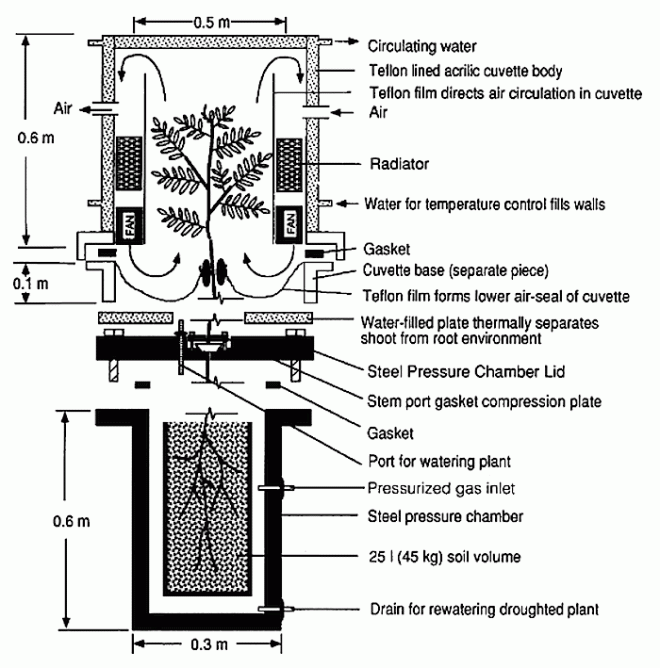Stomatal response to humidity in common bean (Phaseolus vulgaris): Implications for maximum transpiration rate, water-use efficiency and productivity.
P., R. (1993)
in Australian Journal of Plant Physiology 20, 669–691. –
CrossRef |
http://www.publish.csiro.au/?paper=PP9930669
Abstract
Twelve common bean (Phaseolus vulgaris L.) cultivars were grown under greenhouse conditions to study the response of net photosynthesis (A) and transpiration (E) to variation in the leaf-to-air humidity gradient (v). Large differences were observed between cultivars in maximum rates of A and E. The variation in A correlated with both leaf nitrogen content and specific leaf area. Thin leaves had higher nitrogen contents per unit dry weight, but thick leaves had higher nitrogen content per unit surface area.
Photosynthetic nitrogen-use efficiency did not correlate with nitrogen content on either a mass or a surface area basis. Very little variation was found between cultivars in the sensitivity of total leaf conductance (g) to increasing v, when sensitivity was defined as the slope of ln(g) versus v (δln(g)/δv). No significant correlation existed between δln(g)/δv and variation in maximum conductance values.
Much steeper slopes (greater sensitivity) were found in the response of stomatal conductance alone (gs) to the leaf-leaf surface humidity gradient (vs). The sensitivity of stomatal response correlated positively with variation in maximum conductance among cultivars, and, since stomatal conductance was in series with a fixed boundary layer conductance, this positive correlation made possible the uniform sensitivity of g(total) with respect to v(leaf-air) despite the wide variation in gmax.
All cultivars reached their maximum E at very similar v values, and all showed a relatively constant E over a wide range of high v. The implications of this relative homeostasis in E are discussed in the context of possible hydraulic limitations on E.
Considerable recent interest has focussed on the use of carbon isotope discrimination (Δ) as a useful screening character in crop breeding programmes, and Δ has been found to correlate positively with yield in P. vulgaris. We found that Δ measured on bulk leaf tissue, positively correlated with both Amax and gmax between bean cultivars, but did not correlate with instantaneous measures of intercellular CO2 (cI) when v was held constant across all measurements.
This apparent discrepancy may be due, at least in part, to variation in leaf temperatures among cultivars under normal growing conditions. Leaf-energy-budget simulations indicated that the observed range of maximum leaf conductance at low v would generate up to 3.0ºC variation in leaf temperatures under field conditions of low to moderate windspeed.
Given the strong stomatal response to v, this variation in leaf temperature could cause variation in carbon isotope discrimination, which reflects long-term cI values. Such a mechanism of producing variation in cI would not be apparent in cI measurements taken under cuvette conditions where leaf temperature was held constant.
See CSIRO
Full text doi:10.1071/PP9930669



You must be logged in to post a comment.